|
Kudumbigala forest hermitage:
Towering in silent splendour
By Mahil Wijesinghe
Kudumbigala lies majestically on top of a rocky outcrop in newly
acquired Kudumbigala forest reserve in part of the Kumana National Park.
|
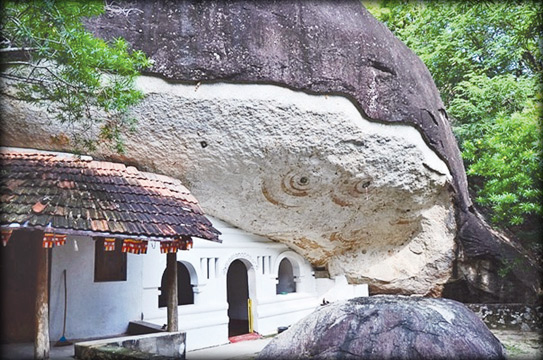
View of Maha Sudharshana Lena |
I saw the isolated Kudumbigala rock in the distance, before I entered
the gravel road which led to the Kumana National Park or Yala East
National Park, 20 kilometres away from Panama in Selawa Eliya, the last
township from the eastern part of Pottuvil.
I made my first visit to this ancient hermitage in 2002 when the
peace accord was signed by then government and the LTTE. I saw hundreds
of Tamil worshippers from the North had travelled by bus to visit the
famous Okanda Hindu Devale at the entrance to the Kumana wildlife
sanctuary. My second visit to Kudumbigala hermitage was in the first
part of 2013 with a group of friends. Many changes have taken place in
and around the Kudumbigala hermitage.
There is a shrub jungle covering thousands of acres. No proper road
runs through it.
Kudumbigala is a sacred Buddhist hermitage surrounded by elephants,
leopards and wild bear, but none of these animals trouble the monastic
monks who meditate in the natural rock caves in the jungle.
Perhaps this may be one reason why monastic monks of a bygone era
chose this quiet place to reflect and meditate on eternity. This sylvan
Buddhist hermitage comprises over 200 natural drip-ledge caves, which
are used by meditating monks as their abodes in the jungle in the past
and continuing to the present. There are a number of ancient rock
inscriptions and ruins such as stone pillars, brick stupas and remnants
of buildings scattered around the Kudumbigala site, some of them have
collapsed. The inscriptions in Brahmi script and other evidence in the
recently discovered cave in the hermitage, Maha Sudharshana Lena , show
that Kudumbigala was established as a forest hermitage in the
pre-Christian era. A stone inscription at the hermitage has it that the
Maha Sudharshana Lena was built and presented to the monastic monks by
Nandhimitra Yodaya, one of King Dutugemunu's Dasa Maha Yodhayas.
|
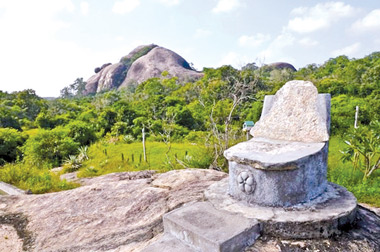
Rock boulder of Kudumbigala forest hermitage with a stupa on
the rock |
|
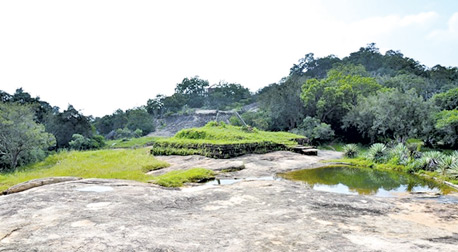
A ruined structure of the hermitage |
|
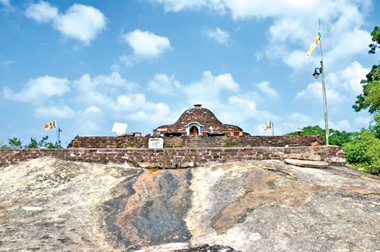
Newly added constructions in Kudumbigala-not in keeping with
this age-old forest hermitage |
When you climb the top of the rock you can see a wonderful scenery
such as the Kumana National Park, the Bagura lagoon and the entire east
coast that is a sight to behold.
Kudumbigala was first established as a refuge for meditative monks
during the time of King Devanampiyatissa. In recent times, it was
re-discovered in 1954 by Ven. Thambugala Anandasiri Thera and Upasaka
named Maithree who made Kudumbigala their home and initiated its
rehabilitation. When they came to Kudumbigala , it was a dangerous place
for humans, as it was overrun by wild animals. However, they were never
harassed.
Today, there is no human habitation around this hermitage.
Kudumbigala stands towering in silent splendour. When I visited this
sacred place in 2002, I couldn't even find the way to the chief monk's
abode. After a painful process, I reached the top of the rock and met
the late chief monk Ven. Sivrumulle Dhammasiri Thera, then he was 55, in
his cave which was scattered with skulls and bones of wild animals. The
Thera's seat was made of a skull of an elephant.
I could photograph the monk in front of his abode on top of the
Kudumbigala rock. This was a rare opportunity as he rarely poses for
photographs.
When Kundumbigala was lying in isolation it turned out that
Kudumbigala was once a haven for treasure hunters. All the stupas have
been destroyed by these treasure hunters.
Even today though peacetimes have dawned Kudumbigala and its environs
could not be safeguarded. Treasure hunters keep looking for abandoned
temples, wild animals are being hunted by poachers and timber racketeers
are destroying precious jungles for timber. In 1994, darkness enveloped
Kudumbigala.
The LTTE had hacked to death 17 civilians in Panama.
Kudumbigala was abandoned and some of the meditative monks moved to
Tharulengala forest hermitage , a branch of the Kudumbigala hermitage
that lies in Hulan Nuge about 50 kilometers west of Kudumbigala.
The only visitor to the Kudumbigala hermitage was Ven. Sivrumulle
Dharmasiri Thera, as chief monk, who made it a point to go there every
now and again. A few years ago, before he passed away, a group of LTTE
terrorists abducted the Thera and severely attacked him before he was
released in the Kudumbigala forest and succumbed due to these injuries.
The present hermitage possesses new constructions of several
buildings and a Buddha statue sculpted out of cement on a rock.
All these new additions have destroyed the ancient grandeur of the
hermitage. In my recent visit I saw numerous new constructions in
different spots in the forest.
These constructions are not in keeping with this age-old forest
hermitage. The authorities in charge of the hermitage at present must
think of the ancient value of the place and avoid modernisation of the
site showing the antiquity of the ancient site.
Today, Kudumbigala forest hermitage is a popular Buddhist hermitage
in the East and a large number of devotees from distance places come to
offer Dana to meditative monks who reside in the caves.
|
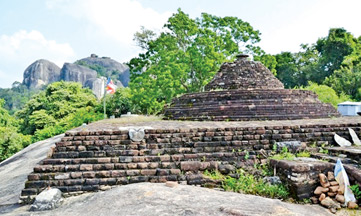
Main Stupa of Kudumbigala forest hermitage |
|

